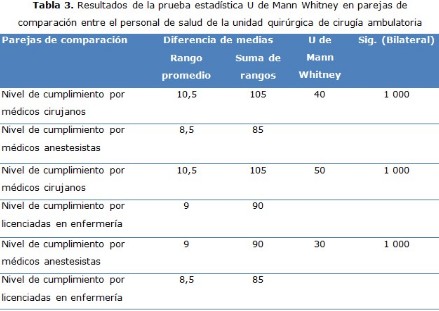Biosecurity measures observance in the ambulatory surgical unit
Keywords:
bioseguridad, unidad quirúrgica, lavado de manos.Abstract
Background: the health workers who manipulate the infectious agents or infected materials must know the possible risks and be experts in their sure manipulation.
Objective: to evaluate the observance level of the biosecurity measures for the health personnel in the ambulatory surgical unit.
Methods: an observational and descriptive study was carried out with a universe of 15 workers of the ambulatory surgical unit, Celia Sánchez Manduley Teaching Provincial Hospital, Manzanillo, Granma, in the first quarter of 2017. The universe was constituted by 7 medical surgeons, 6 graduated nurses and 2 anesthesiologists. The observation was organized for a guide contented of the different articles for each professional for specialty establishing the points.
Results: the biosecurity norms that were completed were always related with the personal aspect, use of surgical clothes, use of protection means, washing of hands and handling of the waste. The use of electronic devices and of jewels was the biosecurity measures that were less respected. The health personnel had a high observance level, since all were positioned in the level three. The observance level that was presented in medical surgeons, anesthetists and nurses was the same one.
Conclusions: the health surgical personnel of the ambulatory surgery unit, completes, in its majority, with the biosecurity norms being the use of jewels and electronic teams the less fulfilled measure.
DeCS: CONTAINMENT OF BIOHAZARDS; HEALTH PERSONNEL; AMBULATORY SURGICAL PROCEDURES; OPERATING ROOMS/standards; EPIDEMIOLOGY, DESCRIPTIVE.
Downloads
References
1.Vera Núñez D. Efectividad de Guía de Buenas Prácticas en la bioseguridad hospitalaria. Rev Cubana Enferm [Internet]. 2017 [citado 01 Dic 2017];33(1):[aprox. 5 p.]. Disponible en: http://www.revenfermeria.sld.cu/index.php/enf/article/view/1208
2.Lee Garcés Y, Guilarte Cuenca M, Toranzo Peña O, García Guerra A, Ramos de la Cruz M. Nivel de conocimientos sobre bioseguridad en Estomatología. Rev inf cient [Internet]. 2017 [citado 01 Dic 2017];96(2):[aprox. 8 p.]. Disponible en: http://revinfcientifica.sld.cu/index.php/ric/article/view/18
3.Mateo Estol BI, Torres Acosta GR, Manet Lahera LR, Saldivar Ricardo IL. Comportamiento de la exposición percutánea y mucosa a sangre y fluidos corporales, en cooperantes cubanos de la salud. Correo Cient Méd Holguín [Internet]. 2016 [citado 01 Dic 2017];20(1):[aprox. 11 p.]. Disponible en: http://www.revcocmed.sld.cu/index.php/cocmed/article/view/1597
4.Romero Ramírez HA. Relación entre el cumplimiento de normas de bioseguridad e incidencia de infección de la herida quirúrgica. Departamento de Cirugía Hospital del Seguro Social de Babahoyo-Ecuador. 2015 [tesis doctoral]. Lima: Universidad Nacional Mayor de San Marcos; 2017 [citado 01 Dic 2017]. Disponible en: http://cybertesis.unmsm.edu.pe/handle/cybertesis/6314
5.Hidalgo Ávila M, Vega Lorenzo Y, Aparicio Álvarez FE, Martínez Lorenzo FY, Carvajal Pérez M, Caraballo Berrío Y. Bioseguridad en tuberculosis. MediCiego [Internet]. 2016 [citado 01 Dic 2017];22(3):[aprox. 9 p.]. Disponible en: http://www.revmediciego.sld.cu/index.php/mediciego/article/view/441
6.Colás Soria L, Iglesia Biot L, López Gonzáles L, Sayú Durand L. Aspectos sobre las medidas de bioseguridad del personal de Enfermería en servicios de hemodiálisis. Rev inf cient [Internet]. 2014 [citado 01 Dic 2017];83(1):[aprox. 8 p.]. Disponible en: http://revinfcientifica.sld.cu/index.php/ric/article/view/995
7.Padrón Vega Y, Moreno Pérez S, Márquez Ferrer A, González Valdés L, Pérez Hernández F. Accidentalidad laboral en expuestos a riesgos biológicos en instituciones de salud. Rev cienc méd pinar río [Internet]. 2017 [citado 01 Dic 2017];21(2):[aprox.8 p.]. Disponible en: http://www.revcmpinar.sld.cu/index.php/publicaciones/article/view/2943
8.Alfaro Velásquez AA, Fuentes Alemán SV. Cumplimiento de medidas de bioseguridad por el personal de salud, Hospital Nacional Santa Rosa de Lima, año 2015 [tesis]. Salvador: Universidad de El Salvador; 2016 [citado 01 Dic 2017]. Disponible en: http://ri.ues.edu.sv/10524/1/50108191.pdf
9.Cobos Valdes D, Vilariño Corella CM, Vázquez Mojena Y, Ramos Lima M. La cultura de seguridad biológica como herramienta básica para el diseño de los documentos de bioseguridad. Rev Cub Hig Epidemiol [Internet]. 2015 [citado 01 Dic 2017];53(3):[aprox. 7 p.]. Disponible en: http://www.revepidemiologia.sld.cu/index.php/hie/article/view/54/86
10.Pérez Díaz M, Crespo Pupo DR. Bioseguridad en los laboratorios de salud. CCM [Internet]. Mar 2014 [citado 5 Nov 2017];18(1):[aprox. 3 p.]. Disponible en: http://scielo.sld.cu/pdf/ccm/v18n1/ccm15114.pdf
11.OMS. Seguridad del personal de salud [Internet]. Ginebra: Organización Mundial de Salud; 2016 [citado 5 Nov 2017]. Disponible en: http://www.who.int/occupational_health/activities/oehcdrom1.pdf?ua=1
12.Martínez Durand MF. Conocimiento y cumplimiento de las medidas de bioseguridad del personal de enfermería del Centro de Salud de San Juan Bautista – Ica [tesis]. Chincha, Perú: Universidad Autónoma de Ica; 2017 [citado 5 Nov 2017]. Disponible en: http://repositorio.autonomadeica.edu.pe/handle/autonomadeica/148
13.Apolo Valarezo MV. Cumplimiento de las normas de bioseguridad del personal de salud en el Hospital Básico Luis Moscoso Zambrano del cantón de Piñas [tesis maestría]. Ecuador: Universidad Técnica de Machala; 2017 [citado 5 Nov 2017]. Disponible en: http://repositorio.utmachala.edu.ec/handle/48000/10353
14.Morales Almeida CA, Orellana Palacios HM, Quesada Gutiérrez CA, Ojeda Orellana MR. Impacto educacional para mejorar conocimientos, actitudes y prácticas en Bioseguridad en la Emergencia del Hospital Vicente Corral Moscoso y del Hospital Homero Castanier. Cuenca 2015. Rev Med HJCA [Internet]. 2017 [citado 5 Nov 2017];9(1):[aprox. 7 p.]. Disponible en: https://www.researchgate.net/.../315951536_Estudio_Cuasiexperimental_Impacto_Educ.

Published
How to Cite
Issue
Section
License
Copyright: Camagüey Medical Archive Magazine, offers immediately after being indexed in the SciELO Project; Open access to the full text of the articles under the principle of making available and free the research to promote the exchange of global knowledge and contribute to a greater extension, publication, evaluation and extensive use of the articles that can be used without purpose As long as reference is made to the primary source.
Conflicts of interest: authors must declare in a mandatory manner the presence or not of conflicts of interest in relation to the investigation presented.
(Download Statement of potential conflicts of interest)
The Revista Archivo Médico de Camagüey is under a License Creative Commons Attribution-Noncommercial-No Derivative Works 4.0 International (CC BY 4.0).
This license allows others to distribute, to mix, to adjust and to build from its work, even for commercial purposes, as long as it is recognized the authorship of the original creation. This is the most helpful license offered. Recommended for maximum dissemination and use of licensed materials. The full license can be found at: https://creativecommons.org/licenses/












 22 julio 2025
22 julio 2025